Optical Constants of Mixed Crude Oil in Visible Waveband Based on the Double-Thickness Transmittance Method
To study the optical properties of mixed crude oil, the optical constants of samples consisting of two crude oils mixed in different proportions were obtained by the double-thickness transmittance method based on transmittance spectra.
To study the optical properties of mixed crude oil, the optical constants of samples consisting of two crude oils mixed in different proportions were obtained by the double-thickness transmittance method based on transmittance spectra. First, the transmittance spectra of mixed crude oil and quartz samples in the wavelength range of 420–900 nm were measured. We then calculated the refractive indexes and absorption coefficient of the samples. The results shows that, in the wavelength of 610–850 nm, the refractive indexes of the optical cell calculated by the double-thickness transmittance method are in the range of 1.4345–1.4729, and the absorption coefficients are between 7.09E-8 and 2.43E-7. The refractive indexes of mixed crude oil are in the range of 1.5132–2.2233, and the absorption coefficients of mixed crude oil are between 3.66E-07 and 1.27E-06. All calculation errors at wavelengths are less than 0.1 and more than 0.0243. The main reasons for these errors are due to measurement and the absorption of the samples. Moreover, there is no linear relationship between the optical constant and the mixing ratio of the sample.
Mixed crude oil is the mixture formed in the crude oil production process (1-2), which affects crude oil production inevitably (3-4). Detection of mixed crude oil plays an essential role in crude oil production. In recent studies, the methods for oil mixture detection include chromatography (5,6), mass spectrometry (7,8), and optical spectroscopy (9,10). Optical spectroscopy was used in this work because it has the advantages of fast detected speed and high accuracy. The optical properties of mixed crude oil are the basic physical properties of mixed crude oil, which is useful for component analysis. However, there is limited research on the optical properties of mixed crude oil.
Methods used to calculate the optical constants of liquid materials include the reflectance and transmittance spectra combination method (11,12), the reflectance method (13), the transmittance method (14), and the transmittance combine with the Kramers-Kronig relation method (15). Among these methods, the double-thickness transmittance method proposed by Tuntomo and Tien (16) is a common method for calculating the optical constants of liquid materials, and has been widely used in the calculation of optical constants in the infrared band (17–19).
The optical constants of liquid materials have been obtained by different calculation methods in many studies. Li and colleagues (20) calculated the optical constants of Chinese diesel using the transmittance of the optical cell filled with liquid materials at two different optical paths based on the search or intelligence arithmetic methods. Ai and associates (21) combined a double-thickness transmission model containing a three-layer structure with a genetic algorithm to determine the spectral radiation characteristics of distilled water, and the result has an agreement with the references. This method was also used to obtain three typical liquid hydrocarbon fuels, and explained the relationship between optical constants and fuel composition, wavelength, and temperature. Wu and associates (22) measured the transmission spectra of polyacrylamide (PAM) solutions at different temperatures in the range of 400–4000 cm-1, and calculated the optical constants of PAM solutions within the temperature range of 20–70 °C by the transmission method combined with the Kramers-Kronig (K-K) relation.
In this paper, crude oil A and the crude oil B acquired from different oil production plants in the Daqing Oilfield were mixed for analysis. The transmittance spectra of mixed crude oil was measured with different mixing volume ratios. All spectra were then separated, according to the different optical paths, to compare them. The optical constants of mixed crude oil were calculated by the double-thickness transmittance method, which is a useful reference technique for crude oil production.
Experimental and Theoretical Method
The optical constants of mixed crude oil contain refractive index n and absorption coefficient k, which need to be indirectly derived from the transmittance spectra of mixed crude oil. The influence of the optical sample cell cannot be ignored in the calculation process, so the optical constants of the optical cells must be calculated first.
Model for Optical Constants of the Optical Cell
Optical constants of quartz optical cell samples were calculated by the double-thickness transmittance method proposed by Li (23). The quartz sample used in the experiment is the same as the material of the optical cell. The optical path L1 and L2 of two quartz samples are 2 mm and 4 mm, respectively, and their transmittance is T1 and T2, respectively. The double-thickness transmittance method is an optical constant inversion method that combines an optical measurement method with an iterative algorithm. The calculation formula of this method is as follows (23):

where p is the interface reflectance of the surface between air and quartz.
To solve the above analytical expressions, a calculation procedure was adopted as the following steps:
1) Give the assumed k values;
2) Calculate the p values by equation 1;
3) Determine the new k’ values by equation 2;
4) Calculate the n values by equation 3;
5) Determine the new p values and T’ by equations 4 and 5;
6) Analyze the calculation errors between T values and the calculated T’ values. If the errors are rational (less than or equal to 0.1%), the calculation is finished; otherwise, the assumed k values will be substituted by the new k’ values and then return to 2.
Model for Optical Constants of Mixed Crude Oil
According to previous studies (24), the equivalent transmittance was proposed to eliminate the multiple reflection effects between the optical window and mixed crude oil based on the transmittance of the optical cell filled with mixed crude oil, as shown in Figure 1a. The calculation formula and procedure are as follows:
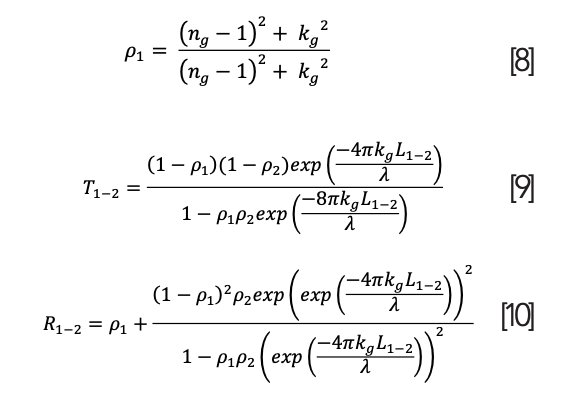

where p1 is the interface reflectance for the surface between air and glass; T1–2 is the transmittance of glass; R1–2 is the reflectance of glass; and T’ is the total transmittance of system.
FIGURE 1: (a) Schematic representation of the optical cell with different optical paths; (b) calculation model of optical constants.
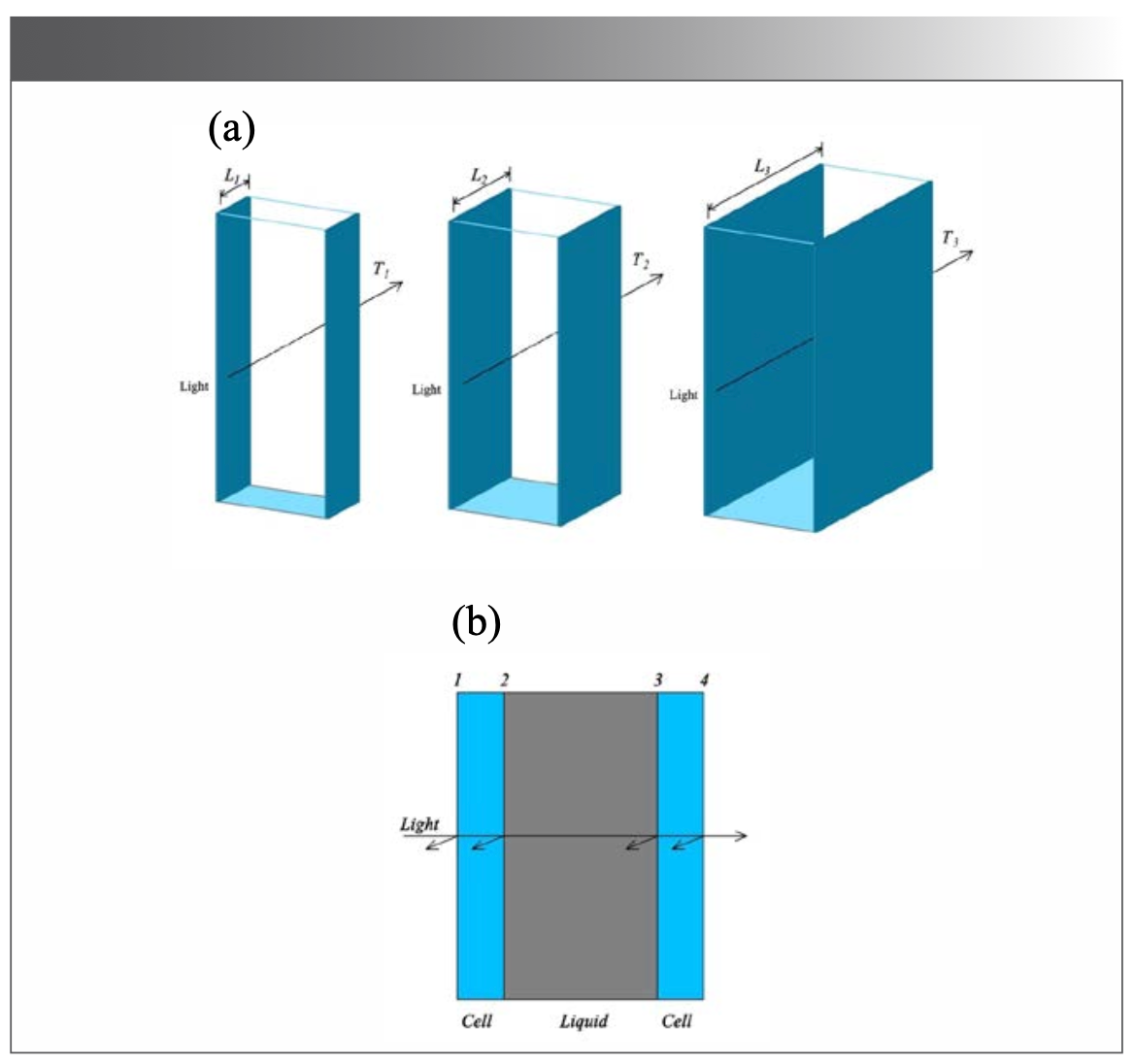
The p2, p3, and p4 can also be calculated by equation 8. T2–3, T3–4, R2–3, and R3–4 can be calculated by equations 9 and 10.
1) Give the assumed k values;
2) Calculate the p values by equation 1;
3) Determine the new k’ values by equation 2;
4) Calculate the n values by equation 7;
5) Determine the T1–2, T2–3, T3–4, R1–2, R2–3, and R3–4 by equations 8, 9, and 10;
6) Determine the new T’ by equation 11;
7) Analyze the calculation errors. The calculation is finished if the errors are rational, otherwise, the assumed k values will be substituted by the new k’ values and then return to 2);
The experimental materials included crude oil A, crude oil B, and petroleum ether. The crude oil samples were brought from different oil production plants in Daqing Oilfield, and the analytically pure petroleum ether was brought from the Damao Chemical Reagent Factory in Tianjin. The experimental instruments used in this work included a double-beam ultraviolet-visible spectrophotometer (TU-1900) and quartz cell (5, 10, and 20 mm).
Crude oil A and crude oil B were mixed to mixed crude oils with different mixing volume ratios, and the mixed crude oil was diluted to 1/500 by petroleum ether. Eleven samples were prepared with crude oil A as the solvent, and crude oil B with a total volume ratio of 10%, 20%, 30%, 40%, 50%, 60%, 70%, 80%, and 90% were added, respectively. Then transmittance spectra of mixed crude oils with different mixing volume ratios at the optical path of 5 mm, 10 mm, and 20 mm were measured by the TU-1900 double-beam ultraviolet-visible spectrophotometer. Finally, samples of the same material as the cuvette were prepared, with a thickness of 2 and 4 mm, respectively, and their transmittance was also measured to calculate the optical constants of optical cells.
Results and Discussion
Transmittance Spectra
The transmittance spectra of mixed crude oil in the range of 420–900 nm were measured with the spectral bandwidth of 1 nm. Due to poor accuracy, data at wavelengths less than 420 nm were discarded. The transmittance spectra at temperature (23 °C) are shown in Figure 2.
Figure 2: Transmittance spectra of mixed crude oil with different mixing volume ratios of (a) the optical path is 5 mm; (b) the optical path is 10 mm; and (c) the optical path is 20 mm.

As shown in Figure 2, mixed crude oils in cells of different optical paths had different transmittance spectra in the range of 450–900 nm. The transmittance of mixed crude oil at the optical path of 5 mm, 10 mm, and 20 mm is in the range of 37.97%–89.27%, 15.73%–86%, and 2.1%–77.73%, respectively. The transmittance raised with the increasing of wavelength when the wavelength was less than 850 nm and then decreased dramatically (850–900 nm). The transmittance of the different cells at the same wavelength decreased, with the cell optical path increasing. Under the same optical path, there is no relationship between the transmittance and mixing ratio. The transmittance of the optical cell is shown in Figure 3. The transmittance of the 2 mm sample is between 78.3% and 93.5%, while that of the 5 mm sample is between 75.4% and 92.5%. It should be noted that the transmittance over 850 nm is not accurate, so the data over 850 nm were not used in this work.
Figure 3: Transmittance spectra of quartz sample with different optical path.
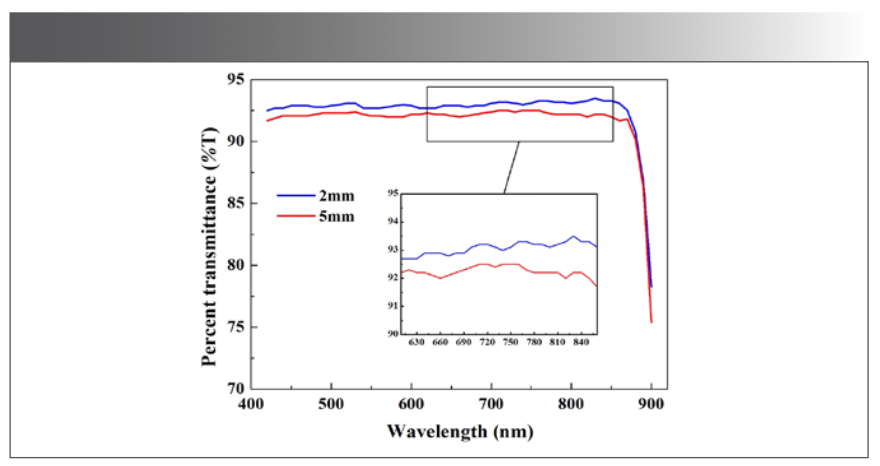
Optical Constants of the Quartz Sample
Optical constants of the quartz sample were calculated by the double-thickness transmittance method, and the result is shown in Figure 4. The range of refractive index n is 1.434–1.472, while the range of absorption coefficient k is between 7.09E-8 and 2.43E-7.
FIGURE 4: Optical constants of the quartz sample: (a) refractive index (n); and (b) absorption coefficient (k).
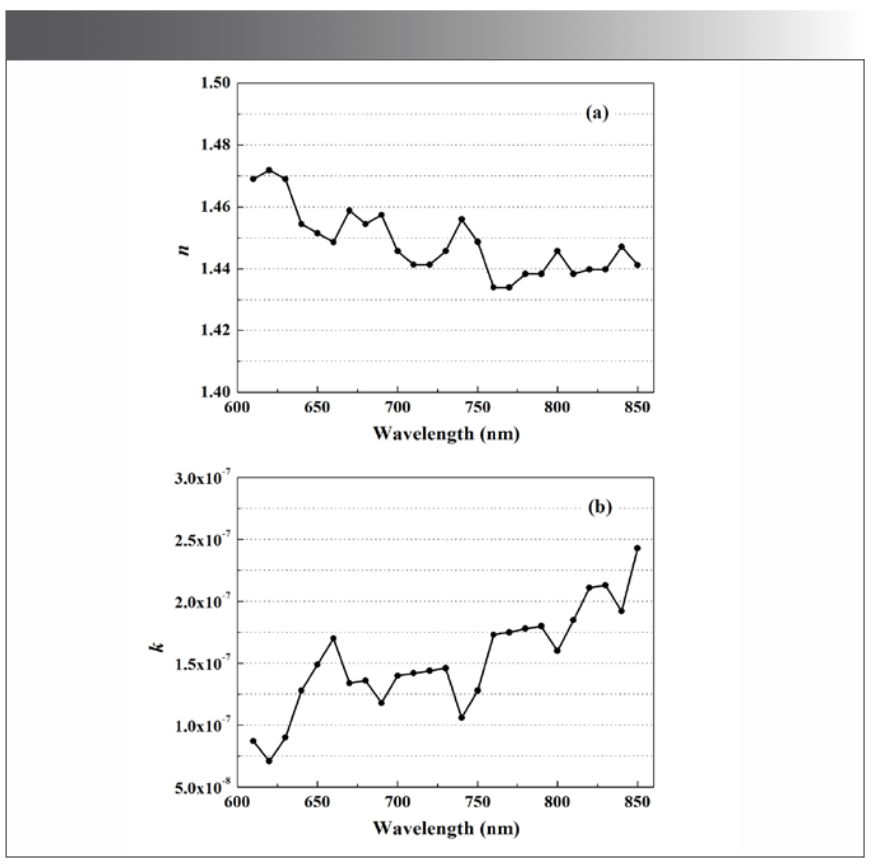
Optical Constants of Mixed Crude Oil
The optical constants of mixed crude oil were calculated by the double-thickness transmittance method based on the optical constants of the optical cell and measured transmittance spectra. The refractive index n and absorption coefficient k in the wavelength range of 610–850 nm are shown in Figure 5. Data with a mixing rate of 80% is missing at wavelengths of 830–850 mm because of the measurement error of transmittance.
FIGURE 5: Optical constants of mixed crude oil: (a) refractive index (n); and (b) absorption coefficient (k).
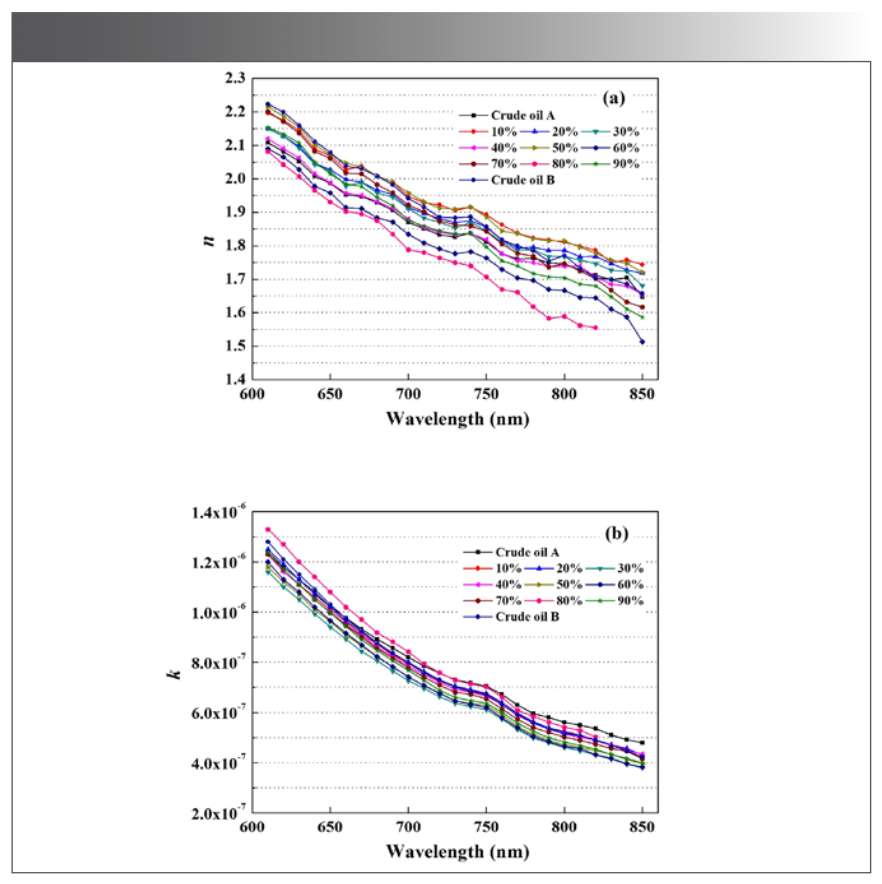
The refractive indexes of mixed crude oil were in the range of 1.513–2.223. Meanwhile, the refractive index curves of mixed crude oils decrease with the wavelength increasing. And the refractive index curve with oil crude A content of 10% deviates greatly from the curve with other content when the wavelength is longer than 740 nm. The absorption coefficients of all samples were in the range of 3.6569E-07 to 1.27E-06, while the absorption coefficient curves increased with the increase of wavelength.
There is a peak at a wavelength of 750 nm for both curves of the refractive index and absorption coefficient, even if this is not obvious. On the other hand, there is no linear relationship between the mixing ratio and refractive index, as well as between attenuation coefficient and oil content.
Error Analysis
The calculation error is defined as the following formula:

where T is experimental transmittance, and T’ is transmittance obtained from inversion calculation. The result is shown in Figure 6:
FIGURE 6: Calculation error of mixed crude oil.

It can be noted that most of the calculated errors are less than 0.1, and the minimum value is 0.0243. All errors decrease as the wavelength increases, which can be attributed to two factors—one is the error generated by the instrument in the experiment, and the other is the absorption of mixed crude oil increases as the wavelength decreases, while the double-thickness transmittance method should be used in the waveband with high transmittance for good accuracy. Furthermore, the errors of mixed crude oil with crude oil B content of 60% and 80% were more unstable than others. The curve of ratio at 60% increases at wavelengths greater than 750 nm and the curve of ratio at 80% increases when the wavelength is greater than 820 nm.
Summary and Conclusion
In this work, crude oil A and crude oil B in different proportions were mixed to prepare samples, and their ultraviolet (UV) transmittance spectra and transmittance of quartz samples were measured. The optical constants of the samples were then calculated by the double-thickness transmittance method.
The following conclusions can be drawn from the above works:
- It is feasible to calculate the optical constants of mixed crude oil by the double-thickness transmittance method. The results indicates that the calculated accuracy increases as the wavelength increases in the UV-visible waveband. Both transmittance and optical constant have no relationship with the mixing ratio of mixed crude oil.
- Both experimental error and low transmittance are important factors affecting the calculation results of optical constants by the double-thickness transmittance method. In this work, only the optical constants of mixed crude oil in the wavelength range of 610–850 nm can be accurately calculated, but the optical constants of other wavelengths cannot be used because of the large calculation error.
Acknowledgments
The research was supported by the Natural Science Foundation of Heilongjiang Province (No. LH2019E015), the Youth Innovative Talents Training Plan of General Undergraduate University in Heilongjiang Province (UNPYSCT-2020148), the Northeast Petroleum University Youth Science Fund Project (No. 2019QNL-14), the Open project of MOE Key Laboratory for Enhanced Oil and Gas Recovery (No. NEPU-EOR-2019-14).
Disclosures
The authors declare no conflicts of interest.
References
(1) Yu, L.; Chen, M.; Xu, Q. Simultaneous Scheduling of Multi-product Pipeline Distribution and Depot Inventory Management for Petroleum Refineries. Chem. Eng. Sci. 2020, 220 (20), 115618. DOI: 10.1016/j.ces.2020.115618
(2) Cafaro, V. G.; Pautasso, P. C.; Cerdá, J.; Cafaro, D. C. Efficient Planning of Crude Oil Supplies Through Long-Distance Pipelines. Comput. Chem. Eng. 2018, 122 (4), 203–217. DOI: 10.1016/j.compchemeng.2018.06.028
(3) Álvarez, P.; Menendez, J. L.; Berrueco, C.; Rostani, K.; Millan, M. Determination of Crude Oil Incompatibility Regions by Ellipsometry. Fuel Process. Technol. 2012, 96, 16–21. DOI: 10.1016/j.fuproc.2011.12.007
(4) Irwin A. W.; Raymond J. K. The Oil Compatibility Model and Crude Oil Incompatibility. Energy Fuels 2000, 14( 1), 56–59. DOI: 10.1021/ef990133+
(5) Xing, C.; Yuan, X.; Wu, X. et al. Chemometric Classification and Quantification of Sesame Oil Adulterated with Other Vegetable Oils Based on Fatty Acids Composition by Gas Chromatography. LWT 2019, 108, 437–445. DOI: 10.1016/j.lwt.2019.03.085
(6) Rodrigues, É. V. A.; Silva, S. R. C.; Romão, W.; Castro, E. V. R.; Filgueiras, P. R. Determination of Crude Oil Physicochemical Properties by High-Temperature Gas Chromatography Associated with Multivariate Calibration. Fuel 2018, 220 (15), 389–395. DOI: 10.1016/j.fuel.2018.01.139
(7) Li, W.; Wang, W.; Mu, H. et al. Analysis of Light Weight Fractions of Coal-Based Crude Oil by Gas Chromatography Combined with Mass Spectroscopy and Flame Ionization Detection. Fuel 2019, 241 (1), 392–401. DOI: 10.1016/j.fuel.2018.12.045
(8) Cao, G.; Ding, C.; Ruan, D. et al. Gas Chromatography-Mass Spectrometry Based Profiling Reveals Six Monoglycerides as Markers of Used Cooking Oil. Food Control. 2019, 96, 494–498. DOI: 10.1016/j.foodcont.2018.103
(9) Wentzell, P. D.; Andrews, D. T.; Walsh, J. M.; Cooley, J. M.; Spencer, P. Estimation of Hydrocarbon Types in Light Gas Oils and Diesel Fuels by Ultraviolet Absorption Spectroscopy and Multivariate Calibration. Can. J. Chem. 1999, 77 (3), 391–400. DOI: 10.1139/v99-041
(10) Hourant, P.; Baeten, V.; Morales, M. T.; Meurens, M.; Aparicio, R. Oil and Fat Classification by Selected Bands of Near-Infrared Spectroscopy. Appl. Spectrosc. 2000, 54 (8), 1168–1174. DOI: 10.1366/0003702001950733
(11) Islam, R.; Rao, D. R. Optical Constants of Polycrystalline ZnSe-CdSe Alloy Films. Opt. Mater. 1997, 7 (1–2), 47–50. DOI: 10.1016/s0925-3467(96)00030-4
(12) El-Zaiat, S. Y.; El-Den, M. B.; El-Kameesy, S. U.; El-Gammam, Y. A. Spectral Dispersion of Linear Optical Properties for Sm2O3 Doped B2O3-PbO-Al2O3 Glasses. Opt Laser Technol. 2012, 44 (5), 1270–1276. DOI: 10.1016/j.optlastec.2011.12.051
(13) González-Leal, J. M.; Márquez, E.; Bernal-Oliva, A. M.; Ruiz-Pérez, J. J.; Jiménez-Garay, R. Derivation of the Optical Constants of Thermally-Evaporated Uniform Films of Binary Chalcogenide Glasses Using Only Their Reflection Spectra. Thin Solid Films 1998, 317 (1–2), 223–227. DOI: 10.1016/s0040-6090(97)00519-1
(14) Dhanasekaran, V.; Mahalingam, T.; Rhee, J.-K.; Chu, J. P. Structural and Optical Properties of Electrosynthesized ZnSe Thin Films. Optik 2013, 124 (3), 255–260. DOI: 10.1016/j.ijleo.2011.11.063
(15) Qi, H.; Zhang, X.; Jiang, M.; Yang, L.; Li, D. Optical Constants of Polyacrylamide solution in Infrared Spectral Region. Optik 2017, 146, 27–32. DOI: 10.1016/j.ijleo.2017.08.055
(16) Tuntomo, A.; Tien, C. L.; Park, S. H. Optical Constants of Liquid Hydrocarbon Fuels. Combust. Sci Technol. 1992, 84 (1), 133–140. DOI: 10.1080/00102209208951849
(17) Li, X. C.; Zhao, J. M.; Liu, L. H.; Tan, J. Y. Optical Properties of Edible Oils Within Spectral Range from 300 to 2500 nm Determined by Double Optical Pathlength Transmission Method. Appl. Opt. 2015, 54 (13), 3886. DOI: 10.1364/ao.54.003886
(18) Li, X.; Liu, L.; Zhao, J.; Tan, J. Optical Properties of Sodium Chloride Solution within the Spectral Range from 300 to 2500 nm at Room Temperature. Appl Spectrosc. 2015, 69 (5), 635–640. DOI: 10.1366/14-07769r
(19) Ai, Q.; Liu, M.; Sun, C.; Xia, X. Temperature Dependence of Optical Constants for Chinese Liquid Hydrocarbon Fuels in the Near-Infrared (NIR) Region from Room Temperature to 400 K. Appl. Spectrosc. 2017, 71 (8), 2026–2033. DOI: 10.1177/0003702817694380
(20) Li, D.; Qi, H.; Wu, G. Determined Optical Constants of Liquid Hydrocarbon Fuel by a Novel Transmittance Method. Optik 2015, 126 (7–8), 834–837. DOI: 10.1016/j.ijleo.2015.02.062
(21) Ai, Q.; Liu, M.; Sun, F.; Liu, C.; Xia, X. Near Infrared Spectral Radiation Properties of Different Liquid Hydrocarbon Fuels. J. Near Infrared Spectrosc. 2017, 26 (1), 5–15. DOI: 10.1177/0967033517744378
(22) Wu, G.; Yang, L.; Qi, H. et al. Optical Constants of Polyacrylamide Solution in the Infrared Between 20 and 70 °C. Optik 2018, 155, 171–178. DOI: 10.1016/j.ijleo.2017.11.004
(23) Li, D.; Ai, Q.; Xia, X. Measured optical constants of ZnSe glass from 0.83μm to 2.20 μm by a novel transmittance method. Optik. 2013, 124 (21), 5177-5180. DOI: 10.1016/j.ijleo.2013.04.001
Hanbing Qi, Haolin Li, Qiushi Wang, Huaizhi Li, and Xiaoxue Zhang are witjh the School of Architecture and Civil Engineering at Northeast Petroleum University, in Daqing, China. Qi and Wang are also with the Heilongjiang Key Laboratory of Petroleum and Petrochemical Multiphase Treatment and Pollution Prevention in Daqing, China. Direct correspondence to Xiaoxue Zhang at duck1208@163.com
Geographical Traceability of Millet by Mid-Infrared Spectroscopy and Feature Extraction
February 13th 2025The study developed an effective mid-infrared spectroscopic identification model, combining principal component analysis (PCA) and support vector machine (SVM), to accurately determine the geographical origin of five types of millet with a recognition accuracy of up to 99.2% for the training set and 98.3% for the prediction set.
Authenticity Identification of Panax notoginseng by Terahertz Spectroscopy Combined with LS-SVM
In this article, it is explored whether THz-TDS combined with LS-SVM can be used to effectively identify the authenticity of Panax notoginseng, a traditional Chinese medicine.